At about 1435 on 7 December 2022, a train collided with a truck and trailer at the Fertilizer Road level crossing near Whangārei. The impact derailed the train’s refuge wagon and toppled the trailer, injuring the rail operator, while the locomotive engineer and the truck’s occupants were unhurt.
Executive summary Tuhinga whakarāpopoto
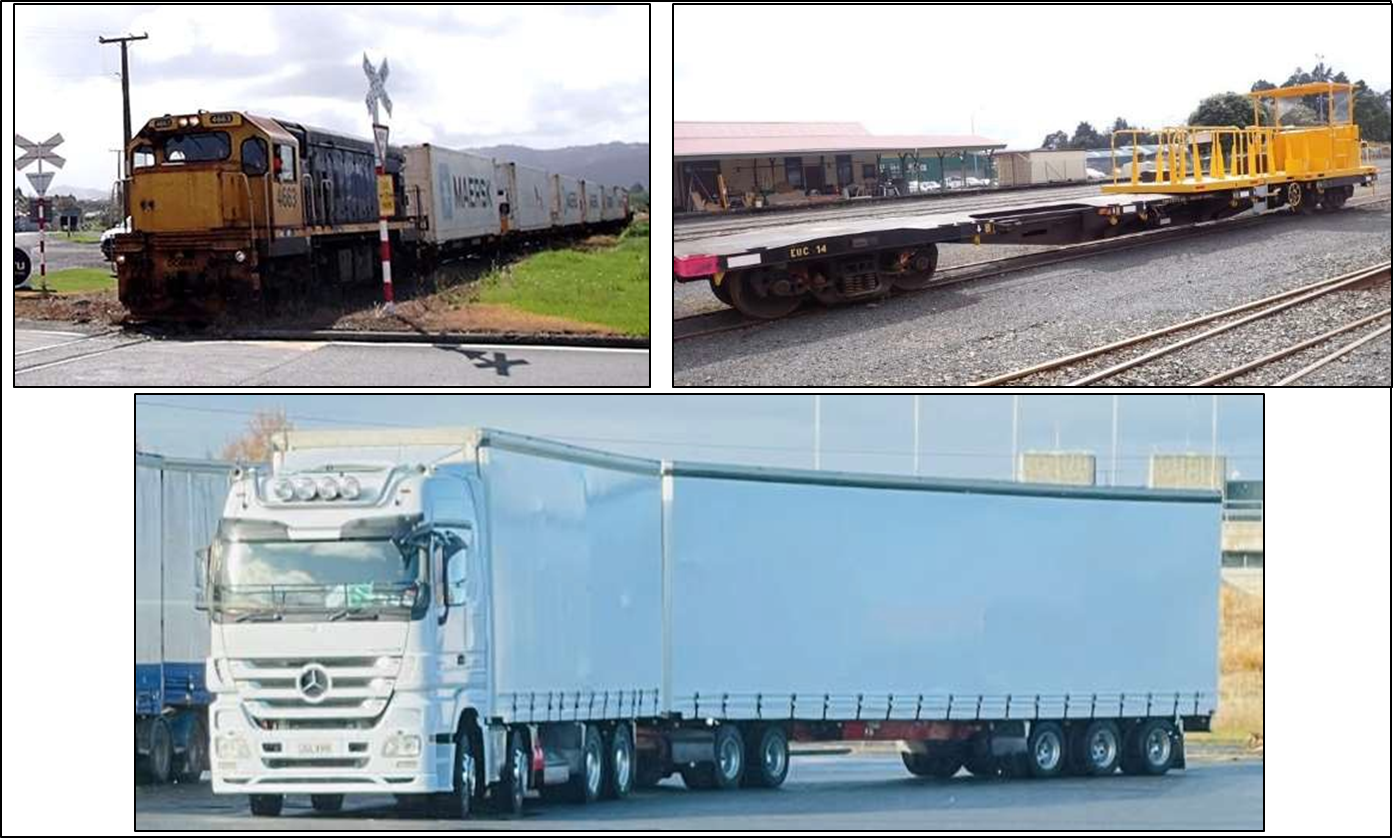

What happened
- At approximately 1435 on 7 December 2022, a train collided with a truck and trailer at the Fertilizer Road level crossing, near Whangārei.
- The truck was crossing the level crossing when the train’s refuge wagon collided with the truck’s trailer. The train travelled another 16 metres before it came to a complete stop. The train’s refuge wagon derailed, and the truck’s trailer tipped onto its side.
- The rail operator was propelled from the refuge wagon and sustained moderate injuries when they fell to the ground. The locomotive engineer and the truck’s two occupants were not injured.
Why it happened
- It is likely that the truck driver saw the train when the truck crossed a preceding level crossing, and perceived that the train was travelling in the opposite direction. It is virtually certain that the truck driver did not expect to see the train approaching the Fertilizer Road level crossing, and consequently did not stop to give way to it.
- The truck driver was engaged in a phone conversation as they manoeuvred a complex intersection. Given the length of time they had been on duty without taking the required scheduled rest breaks, it is likely that their ability to scan and perceive critical information effectively from the road environment was further reduced by the effects of fatigue.
- At the time of the accident, KiwiRail had not conducted a risk assessment for propelling wagons to the Fonterra cool store at Port Whangārei. A formal identification of hazards would likely have led to mitigations that reduced the risk of collision accidents between rail and road vehicles at level crossings on this branch line.
- The train crew did not operate in compliance with the Rail Operating Code as the train approached and entered the level crossing. The Code required the train to be at a lower speed than it was.
- Consultation and collaboration between KiwiRail and the road controlling authority had been ineffective in addressing the risks of hazardous road-user behaviour.
What we can learn
- Road users must always approach railway level crossings with extreme care, particularly those level crossings that have passive protection.
- It is essential that rail vehicle operators adhere to local operating instructions, codes and standards, particularly when propelling on branch lines and in sidings.
- The installation of visual and audible warning devices on all trains with refuge wagons leading would very likely reduce the risk of collisions occurring at level crossings by assisting observers to detect trains and determine their directions of travel.
Who may benefit
- Rail operators, rail staff involved in shunting operations, rail network access providers, road controlling authorities, level crossing assessors, road users and all other road and rail stakeholders may benefit from the findings in this report.
Factual information Pārongo pono
Narrative
Events prior to the accident: the truck
- The truck driver (the driver) had obtained their Class 5 licence and purchased the truck and trailer in 2018. In 2022 the driver had applied to work as a contractor to Mainfreight.
- On 23 March 2022, Mainfreight’s FTL (full truck load) division had offered the driver an opportunity to work in the North Island-based floating fleet. On 11 May 2022 the driver had signed their agreement to comply with Mainfreight’s code of conduct.
- The second driver, who was in the passenger seat at the time of the accident, had arrived in New Zealand on 24 November 2022. They had previously driven heavy vehicles in the United Arab Emirates. Within a week of arriving in New Zealand, they had passed their Class 5 learner licence test. This had been their first step towards converting their overseas driver’s licence to a New Zealand Class 5 driver’s licence. Subsequently, they were required to drive under the supervision of a driver holding a full Class 5 licence.
- In the nine days leading up to the accident, the driver and the second driver had made the following journeys together:
- Auckland to Wellington
- Wellington to Auckland
- Auckland to Tauranga
- Tauranga to Wellington
- Wellington to Masterton
- Masterton to Whangārei (where the accident occurred).
- On 6 December 2022 the driver received instructions from Mainfreight to transport a load of timber and plants from Masterton to Whangārei.
- At 2315 (all times in the report refer to New Zealand daylight saving time (NZDT), UTC+13 and are stated in the 24-hour clock format) the driver and the second driver commenced their shift in Masterton. The second driver operated the truck, under the supervision of the driver, for most of the journey to Whangārei.
- After departing Masterton and while climbing up Saddle Road (see Figure 3) in Manawatū, the truck broke down. The driver parked it at the side of the road awaiting repair.
- At 0053 the driver phoned the local Mercedes Benz service centre to call out a repair mechanic. The fault was traced to an air leak and the truck was repaired. The journey resumed at about 0220.
- The drivers continued towards Marton, then joined State Highway 1 for the remainder of the journey to Whangārei. On their travel north they stopped for fuel in Waiōuru, Taupiri and Silverdale.
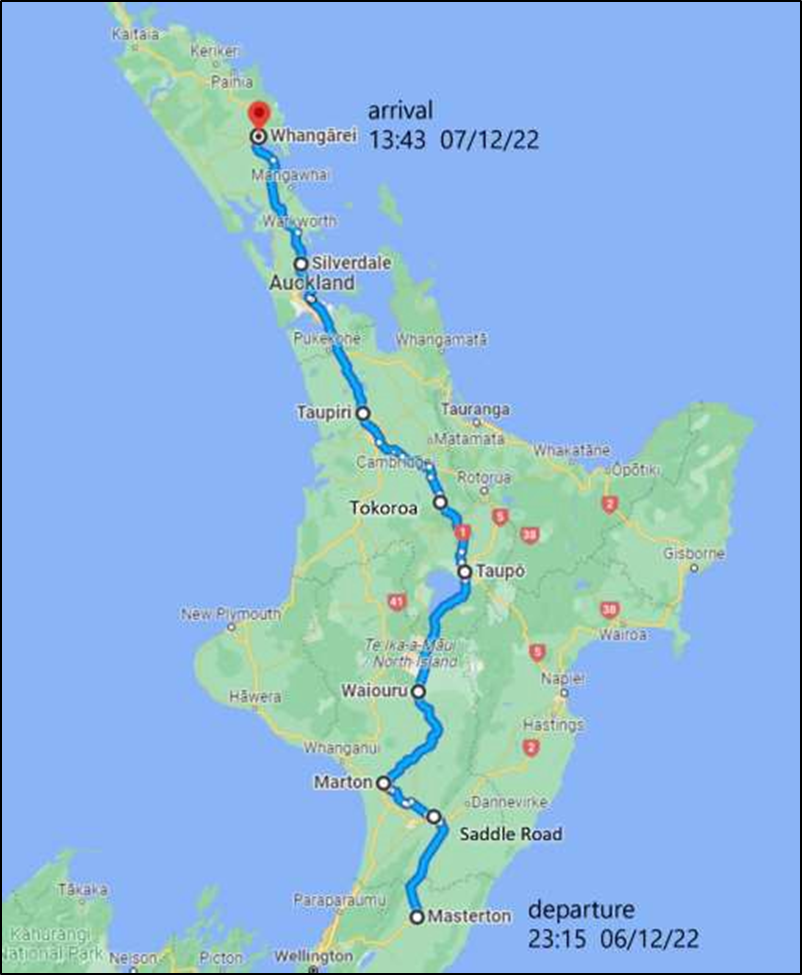
- At about 1343 on 7 December, the truck arrived at Whangārei ITM (Independent Timber Merchants Cooperative Limited) where the bulk of its load was unloaded. Due to restricted space at this location, the driver was then asked to move the vehicle.
- The driver stated in an interview that they had realised at this point that they needed to park somewhere for the required 10-hour break, to avoid exceeding their ‘on duty limit’. In general, drivers must take breaks of at least 30 minutes after 5½ hours of work time, no matter the type of work that takes place during that period (Land Transport Rule: Work Time and Logbooks 2007). In any cumulative work day, a driver may not exceed 13 hours of work time and must have at least 10 hours of continuous rest time (Section 30ZC(2) Land Transport Act 1998. Version as at 1 November 2023). A cumulative work day is a period during which work occurs for no longer than 24 hours, and begins after a continuous period of rest of at least 10 hours (S 2(1) Land Transport Act 1998. Version as at 1 November 2023. Also see https://www.nzta.govt.nz/commercial-driving/commercial-safety/work-time-and-logbook-requirements). The drivers had been due to commence their 10-hour break at 1215.
- At about 1425 the truck left Whangārei ITM. Prior to this the second driver had undertaken most of the driving; however, at this point the owner/driver got into the driver’s seat and started driving the truck towards Fertilizer Road, where there was space to park up and facilities for truck drivers at the Whangārei Mainfreight yard nearby.
Events prior to the accident: the train
- At the time of the accident KiwiRail was running a return freight service between Auckland and Whangārei. The service operated from Monday to Friday and freight consignments included milk products from the Fonterra plant at Kauri, north of Whangārei.
- KiwiRail rostered a two-person crew at the Whangārei freight depot to perform shunting operations from Monday to Friday. The shunt crew consisted of a locomotive engineer (LE) and a rail operator (RO). A single, manually operated DCP class locomotive was prepared and available to the shunt crew for shunting operations.
- As part of their daily duties and prior to the arrival of the morning freight train from Auckland, the shunt crew usually travelled to Kauri to collect loaded wagons from the Fonterra plant. These wagons were taken back to the Whangārei freight depot to be included with the southbound freight train. The shunt crew then took empty refrigerator wagons, which had arrived in the morning freight train from Auckland, to the Fonterra cool store at Port Whangārei.
- At the time of the accident there was no turntable or turning loop at Port Whangārei, so only a single rail line was available for the train to enter and exit the cool store. It was standard practice for the shunt crew to propel the refrigerator wagons to the cool store.
- During propelling movements a locomotive is situated at the rear of the train and a refuge wagon (see Figure 1) is located at the front. Due to the limited sight lines from a locomotive when propelling, it was standard practice for an RO to travel on board the leading wagon, a refuge wagon, and give the LE instructions and information by radio as required to conduct the operation safely.
- At the time of the accident, a new refuge wagon was the leading wagon of the train. It had been delivered earlier that day, attached to the morning freight train from Auckland. It was a converted container wagon with a detachable refuge cassette and intended as an upgrade from the old refuge wagon.
- The shunt to the cool store had not operated for several days, as the old refuge wagon had needed maintenance and the Whangārei freight depot staff were waiting for the new refuge wagon to arrive.
The accident
- At 0800 on 7 December 2022, a two-person shunt crew started their shift at KiwiRail’s Whangārei freight depot. They attended the morning toolbox talk, which was a daily meeting that involved a safety moment and a discussion on the day’s work. They then took Locomotive DCP 4663 to Kauri and returned to the depot with the loaded Fonterra wagons.
- At 1402 freight train 120 arrived at the Whangārei freight depot. This train was the morning freight service from Auckland and included five empty refrigerator wagons and a new refuge wagon. The shunt crew uncoupled and rearranged the wagons from freight train 120 and made up the L1 shunt train to deliver the five empty refrigerator wagons to the Fonterra cool store at Port Whangārei. For this purpose, the L1 shunt train consisted of Locomotive DCP 4663, five refrigerator wagons and the refuge wagon (see Figure 4). As the refuge wagon had initially been facing in the wrong direction, it had to be turned on the turntable before being reattached to the rake of wagons.

- At about 1427 the shunt crew departed from the Whangārei freight depot bound for the cool store, about 5 kilometres (km) down the track (see Figure 2). The RO was positioned in the refuge wagon, in the leading direction of travel, and calling out distances and instructions to the LE over the radio.
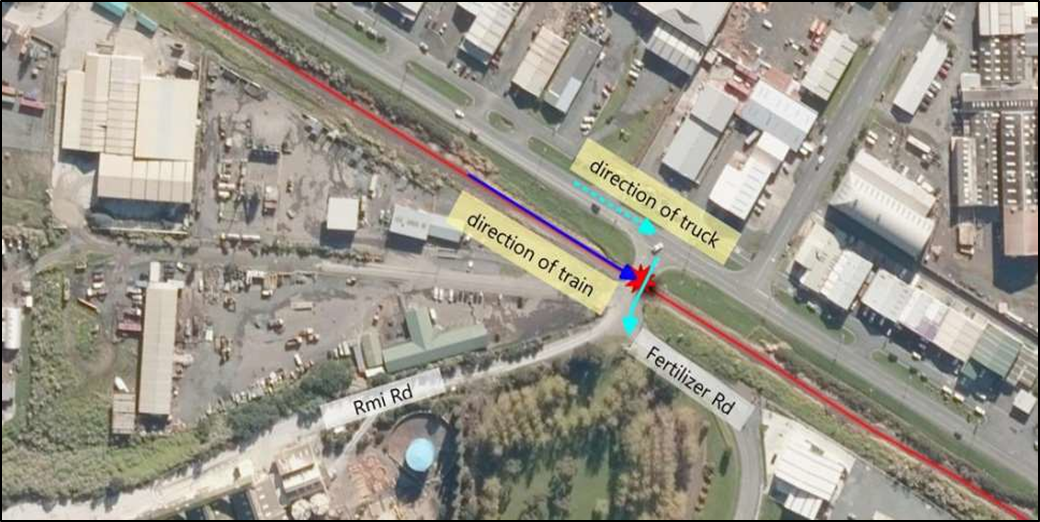
- The RO recalled that there were no issues as they approached the Kioreroa Road level crossing, which was protected with warning bells and lights, but no barrier arms. The Kioreroa Road level crossing was the only level crossing between the depot and the port that had active warning devices. There were another four main level crossings on the route that were passive level crossings. As they approached the level crossing at Fertilizer Road, the RO noticed the truck and trailer on Port Road indicating to turn right (see Figure 5).
- Closed-circuit-television footage showed that at about 1435 the truck approached the intersection of Port Road and Fertilizer Road. At 1435:18 the truck turned right and proceeded across the level crossing at about 20 km per hour without giving way to the approaching train. At the same time the LE sounded the locomotive’s horn.
- The train was approaching the level crossing at about 14 km per hour. The RO and the LE were both aware of the truck and the possibility that it would not stop at the level crossing. The train was almost on the level crossing when the RO realised the truck was not going to stop. They called to the LE, ‘Stop, stop, stop!’ over the radio.
- At 1435:25 the LE applied a full-service brake, thinking they were applying the emergency brake, and the collision occurred. The RO felt the brake application but knew they could not avoid the collision, so ran back down the refuge wagon to ‘bail off’.28 Two seconds after the collision, the refuge wagon derailed and the RO was propelled off the wagon onto the road on the right-hand side of the train.
- The train’s momentum caused it to continue moving for another 16 metres (m) along the track as the refuge wagon derailed and the truck’s trailer tipped over on its side (see Figures 6 and 7). At 1435:33 the train stopped.
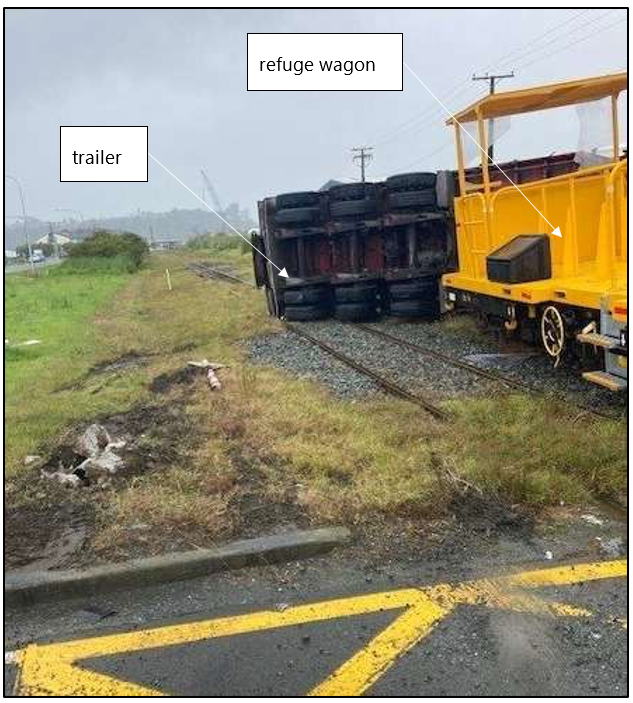
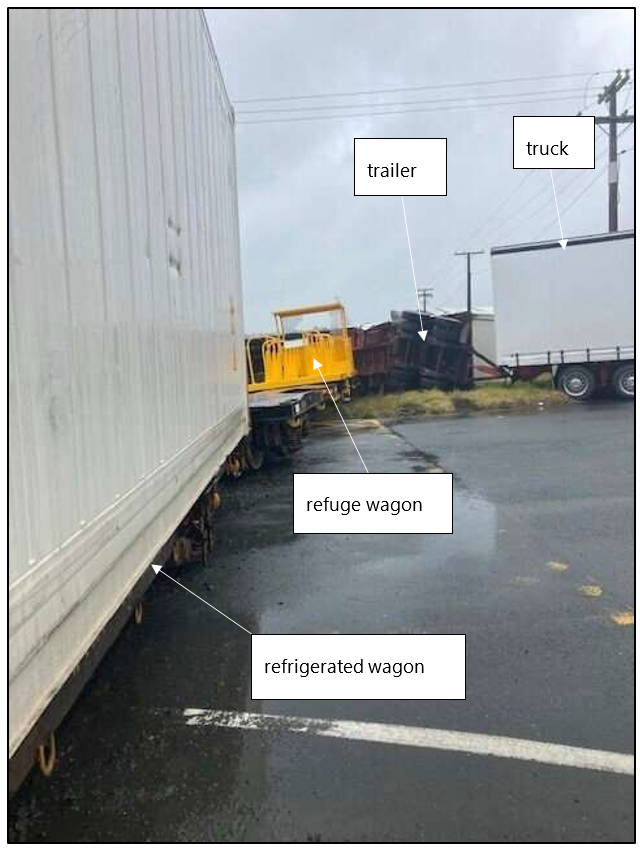
- Staff from a nearby business attended to the RO and called for emergency services. The RO was the only person injured; they suffered a broken collar bone and sprained wrist. The truck’s trailer was extensively damaged, and the damage to the refuge wagon comprised a broken airline, damage to the protected area and a broken window.
Personnel information
- The LE was employed by KiwiRail and had more than 50 years’ operating experience. They were certified as an LE and their most recent revalidation, required every two years, had been completed on 9 February 2021. Their previous safety observation had taken place on 19 October 2022. This had included an assessment of their signals and rule-based knowledge out on the main line and a review of their train-handling practices to ensure they met the current rules, codes and standards. Having worked in Whangārei, Westfield and Tauranga earlier in their career, the LE had held their current position at the Whangārei freight depot since 2012.
- The RO had completed their training and certification in yard and main line rail operations on 21 July 2021. This had included theory and practical training carried out at KiwiRail’s training facility in Lower Hutt, followed by on-the-job training at the Whangārei freight depot. The RO had also completed a revalidation paper for yard-based functions on 21 December 2021.
- Formal safety observations were completed every eight months to ensure that staff remained proficient in and compliant with operating procedures. The Whangārei team leader had completed the RO’s safety observation, for train examination and freight shunting, on 30 May 2022. The Whangārei team leader had also completed the LE’s safety observation checklists for main line locomotive driving on 19 October 2022.
Train/Vehicle information
- Locomotive DCP 4663 was a DCP class locomotive, manufactured by General Motors Canada in 1958 and rebuilt in the late 1970s.
- The purpose of the refuge wagon was to provide a safe place for the RO to conduct piloting duties during propelling operations. The EU14 refuge wagon had a steel sheltered area with additional brace plating that was intended to provide the RO with protection from collision.
Meteorological information
- Prior to and at the time of the accident, it was raining moderately.
Recorded data
- Locomotive DCP 4663 was fitted with a Tranzlog data recording system, which captured the train’s location, speed, throttle, horn and brake-application inputs.
- The truck was fitted with a NavMan location tracker and AutoSense driver monitor.
- Investigators analysed the data from these devices as well as cell phone records and closed-circuit television recordings from local businesses.
Site and wreckage information
- Fertilizer Road was a sealed, two-way, no-exit public road providing access to nine businesses. A level crossing was located at the intersection of Port Road and Fertilizer Road (see Figure 8). It was protected by ‘give way’ signs only, so was defined as a passive level crossing. The onus was on road users to obey these warning signs and always look for trains and check that the tracks were clear of trains before crossing (Land Transport (Road User) Rule 2004 clause 9.2(2). Version as at 19 May 2022). There were no advance warning signs to assist road user awareness as they approached the level crossing from either direction on Port Road. Signage requirements are discussed in Section 3 of this report (see paragraph 3.26).
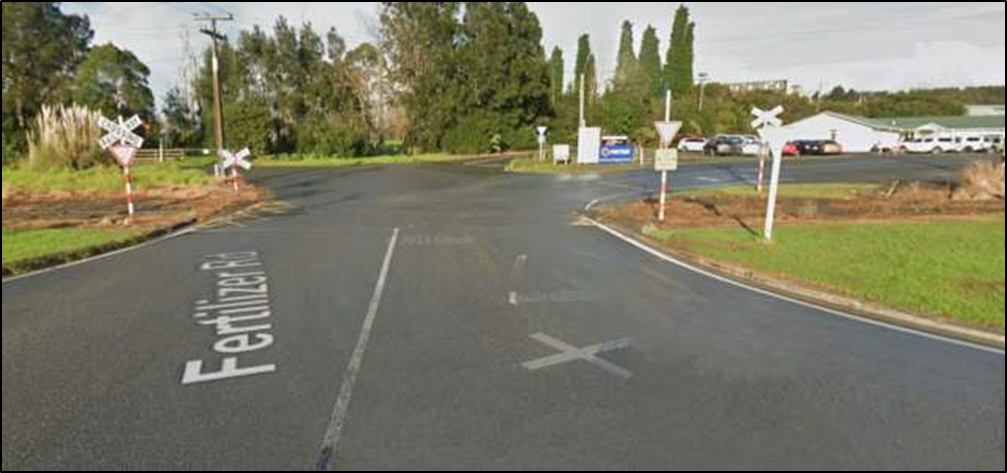
- The Railways Act 2005 (Railways Act 2005, sections 81(1)-81(4)) and Land Transport Rule: Traffic Control Devices 2004 (Land Transport Rule: Traffic Control Devices 2004 (Rule 54002/2004), clause 9.2). require the rail access provider and the road controlling authority to collaborate in determining the appropriate notices and warning devices necessary for the protection of people using level crossings.
- The railway line to Port Whangārei is regarded as an extension of the Whangārei freight depot, therefore the local depot instructions and procedures apply to the line. Where the line runs adjacent to Port Road, there is vegetation growing on each side of the rail corridor. Whangarei District Council employs contractors to maintain and remove vegetation along the corridor.
Organisational information
- KiwiRail Holdings Limited, trading as KiwiRail, was the operator of the train and maintained the railway infrastructure as the rail access provider.
- The driver was self-employed and held an agreement with Mainfreight to operate as part of Mainfreight’s FTL division floating fleet.
Other relevant information
Relevant legislation
- Section 80 of the Railways Act 2005 states that any rail operator, or person responsible for the driving or control of a rail vehicle, is entitled to assume that all persons and vehicles not using a railway line will keep clear. However, if they have reason to believe that a collision is likely to occur, they must take all reasonable steps to prevent it.
-
Clause 9.1 of the Land Transport (Road User) Rule 2004 states that:
(1) A person approaching or crossing a level crossing must keep a vigilant lookout for any approaching rail vehicle using the railway line.
(2) A driver must give way to a rail vehicle using the railway line that is approaching and within 800 metres of the level crossing.
-
Clause 9.2(2) specifies that:
A driver approaching a level crossing that is controlled by a give-way sign must give way to any rail vehicle that is approaching or crossing the level crossing.
-
Section 81 of the Railways Act 2005 describes the responsibilities of a rail access provider and a road controlling authority with respect to notices and warning devices at level crossings, and states in part:
(1) The licensed access provider for a railway line may cause to be erected at each level crossing of the railway line the notices and warning devices that the licensed access provider considers necessary for the protection of persons using the level crossing.
(2) When considering what is necessary for the protection of persons using the level crossing, the licensed access provider must consult with any other persons directly involved with the operation or management of the level crossing, including (but not limited to) a road controlling authority or adjacent landowner, with the objective of agreeing on the notices and warning devices to be erected.
-
Clause 9.2 of the Land Transport Rule: Traffic Control Devices 2004 also describes the responsibilities of the rail access provider and the road controlling authority with respect to warning signs at level crossings, stating:
(1) To inform road users of a level crossing and to promote safe responses from road users approaching and crossing the level crossing, a road controlling authority:
- must install warning signs on a public road in advance of the level crossing; and
- may install warning signs on any other road in advance of a level crossing; and
- may provide other traffic control devices in advance of the level crossing.
(2) A rail access provider, after consultation with the road controlling authority, may install warning signs and other appropriate traffic control devices at a level crossing to promote safe responses from road users at the level crossing.
- Part 9 of the Traffic Control Devices Manual (the TCD Manual) produced by Waka Kotahi NZ Transport Agency (Traffic Control Devices Manual. Part 9 Level Crossings. 2nd edition, amendment 1. New Zealand Transport Agency, December 2012) provided guidance on industry good practice focusing on level crossings, and included practices mandated by law. The TCD Manual Part 9 was developed under the guidance of subject-matter experts and in consultation with affected organisations.
- Section 30ZC(2) of the Land Transport Act 1998 (Land Transport Act 1998, section 30ZC(2). Version as at 15 June 2023) states that in any cumulative work day a driver may not exceed 13 hours of work time and must have at least 10 hours of continuous rest time. Land Transport Rule: Work Time and Logbooks 2007 sets out how the limits to the work-time hours for commercial drivers in New Zealand are to be administered (Land Transport Rule: Work Time and Logbooks 2007. Version as at 1 May 2021).
Level crossing safety assessments
- KiwiRail used a combination of tools to determine a risk rating for level crossings throughout the New Zealand rail network. The resulting risk rating helped to determine the appropriate level of protection and what safety treatments were appropriate to reduce risks so far as was reasonably practicable.
- One of the tools used by KiwiRail to assess risks at level crossings was the Australian Level Crossing Assessment Model (ALCAM). ALCAM was included as an appendix to the TCD Manual Part 9 and recommended for use in conjunction with other safety and engineering assessments. The ALCAM model comprised three components: the infrastructure model; the exposure model; and the consequence model. When combined, these components produced a unique risk score for each level crossing.
- Another risk assessment process, the Level Crossing Safety Impact Assessment, was introduced in 2022 to produce a level crossing safety score for use in conjunction with the ALCAM rating.
- At the time of the accident the most recent ALCAM update for the Fertilizer Road level crossing was dated 21 May 2021, and ranked the Fertilizer Road level crossing as the 1922th most hazardous level crossing in New Zealand (out of 2892 public and private crossings) (see Appendix 1).
Previous occurrences
- The Transport Accident Investigation Commission (the Commission) has investigated numerous level crossing accidents in recent years. These have included:
- the near-collision incident between a freight train and a bus at Selwyn Street level crossing in Christchurch, 8 August 2022 (RO-2022-103)
- the collision between a freight train and a light truck at Saunders Road, Marton, 13 May 2021 (RO-2021-102)
- the collision between a locomotive and a bus at Clevely Line, Bunnythorpe, Manawatū-Whanganui, 16 September 2020 (RO-2020-103)
- the collision between the Coastal Pacific passenger train and a truck at Mulcocks Road, Waimakariri, 10 February 2020 (RO-2020-101)
- the collision between a freight train and a car at Piako Road, Morrinsville, Waikato, 7 December 2019 (RO-2019-108)
- the collision between a freight train and a rubbish truck at Lambert Road, Kawerau, Bay of Plenty, 6 October 2017 (RO-2017-105).
Analysis Tātaritanga
Introduction
- The Commission uses a watchlist to identify pressing transport safety concerns of high social, economic or environmental risk, and systemic transport safety risks. Level crossings are where the rail and road networks meet, along with the unique hazards and risk profiles of each network. Since 2016 the Commission has considered ‘safety for pedestrians and vehicles using level crossings’ a watchlist item.
- Legally (see paragraphs 2.46-2.47), a rail access provider and a road controlling authority must consult each other when deciding on the safety controls necessary to make a level crossing as safe as is reasonably practicable. Best-practice guidance for the land transport sector, provided in the TCD Manual Part 9, promotes this shared responsibility.
- The following section analyses the circumstances surrounding the event to identify those factors that increased the likelihood of the event occurring or increased the severity of its outcome. It also examines any safety issues that have the potential to adversely affect future operations.
Propelling over passive level crossings
Safety issue: Propelling movements occurred regularly at the accident location. No risk assessment had been completed to understand the hazards involved with propelling, and therefore no preventive controls were in place. This increased the risks to both rail and road users.
- The run to the cool store was part of the shunt team’s Monday-to-Friday daily duties. It was conducted as a propelling movement because there was no turntable or turnaround loop at the cool store.
- Shunting operations are hazardous by nature due to the requirement for people to work in close proximity to heavy, moving rail vehicles. Additionally, where a railway meets a road, the hazards of the rail and road network are combined. Due to the nature of rail transport, rail vehicles do not have the freedom of lateral control to avoid hazards on tracks. An LE has the use of lights for visibility, a horn as an audible warning device and a braking system to stop the train.
- In Whangārei, the line between the freight depot and the Fonterra cool store was considered an extension of the freight depot (rules and procedures within station limits apply as opposed to main-line rules). There were five main level crossings on this route, but only one had warning lights and bells. The rest had passive protection, where the onus is on road users to obey any warning signs, keep a vigilant lookout and ensure that a track is clear before crossing. The Fertilizer Road level crossing was protected by give-way signs only, so it was defined as a passive level crossing.
- When the Commission’s investigators were at the Fertilizer Road level crossing to re-enact the accident, one vehicle was seen overtaking another vehicle that was stopped at the level crossing as the locomotive approached. This was despite an investigator telling the road user that there was a train approaching.
- Satellite tracking data showed that the driver did not stop and give way to the approaching train (see Figure 9). Information provided by the driver during the investigation supported this and it is considered virtually certain that the driver did not see the train, or expect to see a train, at the Fertilizer Road level crossing. The driver initially stated that they had seen the train while passing an earlier level crossing just after they had left Whangārei ITM. However, due to the position of the locomotive at the rear of the train, it is possible that the driver thought it was travelling in the opposite direction to the truck.
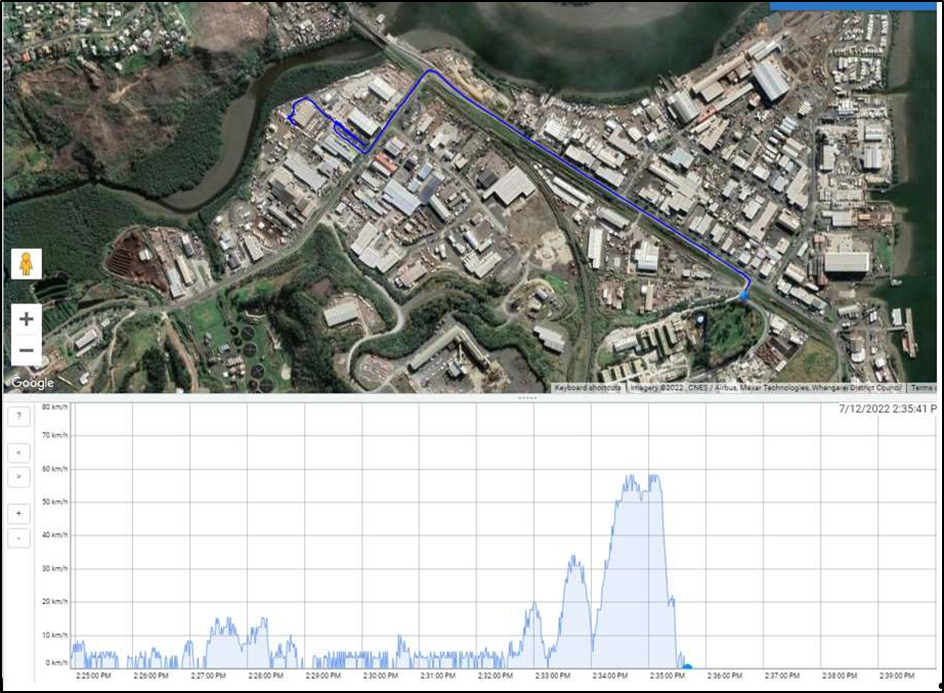
- Turning into Fertilizer Road required the driver to manoeuvre a complex intersection containing a rail crossing. The use of a cell phone during this activity very likely increased the demand on the driver’s attention and impaired their driving performance. Research has demonstrated that impairment can occur either by increasing a driver’s overall cognitive workload or by introducing additional competition between shared information-processing resources (see Wickens et al., 2015). The driver was not using a hand-held cell phone; however, research has demonstrated that cognitive interference still occurs when using hands-free systems (see Caird et al. (2018)).
- At the time of the accident the truck driver had been on duty for over 13 hours. Satellite tracking data indicated that the statutory rest breaks (Land Tranport Act 1998, s30ZC(2)) had not been adhered to. Fatigue is a well-known risk factor for road accidents (see Bioulac et al. (2017) for a recent literature review) (Bioulac, S., Micoulaud-Franchi, J. A., Arnaud, M., Sagaspe, P., Moore, N., Salvo, F., & Philip, P. (2017). Risk of motor vehicle accidents related to sleepiness at the wheel: a systematic review and meta-analysis. Sleep, 40(10), zsx134) as it affects reaction time, error rates, attention and capacity. Given the length of time the driver had been on duty without taking the required scheduled rest breaks, it is likely that their ability to scan and perceive critical information from the road environment effectively was reduced by the effects of fatigue.
- When conducting propelling operations, the LE was positioned at the rear of the train. In this case the LE was more than 100 m behind the front of the refuge wagon and operating the locomotive in reverse. Locomotive DCP 4663 did not have duplicated indicators and controls, so the LE was travelling and working in reverse, using the opposite hand to the one they used when driving forwards, and had to turn around to look at the indicators and controls. Additionally, the LE’s sight lines were limited when the locomotive was driven in reverse. A full and thorough risk assessment of propelling operations in Whangārei would likely have identified the added risk of the ergonomic set-up of Locomotive DCP 4663.
- There are significant differences between propelling operations and locomotive-led pulling operations. A full and thorough risk assessment would likely have identified the risks involved with an operation where the LE, along with the train’s headlights, ditch lights and whistle, were displaced from the front of the train. Due to the infrequency of propelling operations in public areas, road users and pedestrians could possibly have difficulty perceiving that a propelling train is moving towards them
- The run from Whangārei freight depot to the cool store involved crossing one active and four passive level crossings where staff had noted poor road user behaviour. The staff at Whangārei freight depot referred to the cool store run as ‘running the gauntlet’ because near misses occurred almost daily. KiwiRail staff could have reported these near misses to the Police. However, in the past they had found this reporting to be ineffective unless they could provide the Police with registration numbers of the offending road vehicles. From their usual operating positions, KiwiRail staff were unable to see the registration plates of the offending vehicles. Due to the perception that there would be no follow-up action from the Police, the additional administrative work required to enter a level crossing complaint was not considered worthwhile. Although staff at the Whangārei freight depot talked to each other about these near-miss incidents, they rarely recorded them in the KiwiRail incident reporting database. The informal identification and acceptance of the risk meant that no proactive measures were taken to improve safety at the level crossings.
- At the time of the accident there were nine businesses located on Fertilizer Road. At least three of these businesses had regular heavy-vehicle traffic. Truck and trailer combinations travelling to and from the Mainfreight depot were usually over 20 m in length. Truck drivers had to be mindful of the 15 m distance from the edge of Port Road to the stop line at the level crossing. This restricted space presented a hazard known as short stacking, where a truck could be left obstructing Port Road if required to stop at the level crossing.
- KiwiRail had various administrative safety measures that could have reduced the overall risk of accidents occurring at level crossings. However, these were largely unsupported and not in common practice at the Whangārei depot. When circumstances and conditions aligned to create the potential for this accident, these administrative safety measures proved ineffective in preventing it. For example, KiwiRail’s local operating procedures and the Rail Operating Code (the Code) included a walking pace (5 km per hour) speed limit for propelling across passive level crossings. Additionally, the Code required that a shunting crew stop short of a passive level crossing while the RO stopped road vehicles and then called the train onto the level crossing. The effectiveness of these administrative safety measures was dependent on training and active supervision to ensure crews’ adherence with the rules and operating procedures.
- Safety observation checklists were completed to ensure staff were carrying out their duties in accordance with the Code and local operating procedures. However, these checks were carried out on the main branch line, not on the cool store line where propelling occurred. This meant there was no opportunity to identify whether the shunting crew were not following procedures when propelling across passive level crossings.
- The last ALCAM assessment (see Appendix 1) prior to the accident had identified hazards at the Fertilizer Road level crossing that included:
- short stacking
- queueing
- visibility of trains for vehicles approaching the level crossing
- heavy vehicle traffic
- partial conformance with the TCD Manual Part 9
- poor distance from advance warning to the level crossing
- proximity to an intersection.
- KiwiRail staff had informally identified poor driver behaviour as an everyday part of the working environment. Other than being aware of this, no safety measures had been introduced to reduce the risk of accidents.
- A formal risk assessment of the propelling operation between the Whangārei freight depot and the cool store should have considered the hazards identified in the ALCAM assessment. It would very likely have highlighted the importance of following the correct procedures and the need to conduct safety observations of propelling movements. It would also likely have identified the partial conformance with the TCD Manual Part 9 with respect to advance signage at the Fertilizer Road level crossing. The risk assessment process might have also initiated better consultation with Whangarei District Council, the road controlling authority.
- The absence of a formal risk assessment for propelling in this location has the potential to adversely affect future operations. The Commission has issued a recommendation to KiwiRail to address this safety issue (see Section 6).
Collaboration between the rail access provider and the road controlling authority
Safety issue: Consultation and collaboration between the rail access provider and the road controlling authority on providing adequate protection at the Fertilizer Road level crossing was ineffective, resulting in a failure to carry out required maintenance.
- In April 2022 KiwiRail and Waka Kotahi published a guidance paper (Level Crossing Risk Assessment Guidance (2022), version 5, developed for KiwiRail and Waka Kotahi by Stantec NZ Limited, April 2022) for road controlling authorities assessing level crossing risks. The paper included a proposal that level crossings in New Zealand be managed using the safe system approach that was applied to other transport infrastructure. It highlighted the importance of the following concepts:
- humans make mistakes (but should not be disproportionately punished for them)
- humans are vulnerable to injury (leading to a focus on harm minimisation)
- a shared responsibility is required to address safety (among rail operators, road controlling authorities and other system users).
- This shared responsibility for a safe transport system aligned with a legal requirement for consultation between the rail access provider and road controlling authorities in determining the levels of risk and the appropriate safety treatments at level crossings.
- Using a combination of tools (ALCAM and the Level Crossing Safety Impact Assessment), level crossings were assessed to determine the risk ratings and safety treatments that were appropriate to reduce the risks to level crossing users to as low as reasonably practicable.
- Fertilizer Road was a sealed, two-way, no-exit public road providing access to nine businesses. The level crossing was a passive level crossing protected by give-way signs. This level of protection relied on the road users approaching the level crossing with care and making observations to determine that the railway line was clear before proceeding across the level crossing. Railway crossbuck signs had been installed to alert road users to the level crossing, and give-way signs had been installed to cue road users of the appropriate action. Other than faded, yellow-painted box markings on the road, there had been no signs to alert road users of the level crossing.
- The give-way and crossbuck signs had been installed in 1999 during a Tranz Rail campaign called ‘Operation Crossbuck’. Although historically traffic in the Port Whangārei area had been considered light, in recent years there had been an increase in traffic. The Commission was advised that there had been a significant increase in heavy vehicles operating in the port area and accessing the industrial area at Fertilizer Road. Although there were only four rail movements on weekdays at the level crossing, the increase in road traffic – long vehicles in particular – would very likely have changed the risk profile between 1999 and 2022. However, no changes had been made to the level of protection at this level crossing in that time.
- When the signage and traffic control devices installed at the Fertilizer Road level crossing are considered in relation to those that may be expected by close adherence to the TCD Manual Part 9, it is apparent that there could be more effective protection at this level crossing. Figure 10 shows an intersection and level crossing layout similar to that where Fertilizer Road meets Port Road. The Fertilizer Road intersection is more complex than that illustrated, as three roads converge into a single access to and from Port Road. The green ticks indicate the give-way signs, with attached crossbuck signs, that were installed but not angled towards the traffic approaching from up and down Port Road. The red crosses indicate signage that should have been installed to warn drivers of the upcoming level crossing, but were not present at the time of the accident.
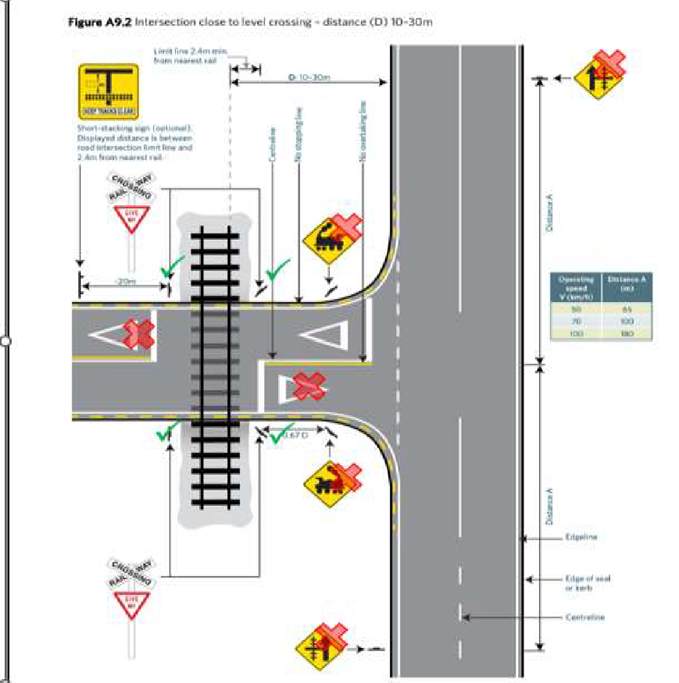
- In determining whether a level crossing requires a give-way sign, a stop sign or active protection, sight-line requirements are calculated based on the speed of approaching vehicles and trains. The ALCAM assessment for this level crossing identified an issue with the sight lines, and in accordance with the TCD Manual Part 9, a stop sign would have been more appropriate, as would have been a consideration of active protection.
- The ALCAM assessment of this level crossing identified several risk factors, including its partial conformance with TCD Manual Part 9. Other risk factors included short stacking, the concentration of heavy vehicles using the level crossing, sight lines, and queueing. The TCD Manual Part 9 specifies the parameters used to determine whether a level crossing is protected with give-way or stop signs or if active controls should be considered. Despite there being only four rail movements a day across the level crossing, the road traffic had increased noticeably and the consequences of a road/rail collision were potentially severe. Aside from the ‘Operation Crossbuck’ correspondence from Tranz Rail in 1999, neither KiwiRail nor Whangarei District Council was able to provide the Commission with evidence of collaboration or communication in assessing the safety at this level crossing.
- Guidance on level crossing risk assessments stated that KiwiRail and road controlling authorities needed to work together closely to conduct safety assessments at level crossings. This included providing the road controlling authority with permits to enter the rail corridor where necessary. However, road controlling authorities reported that they had been restricted by the Permit to Enter system to such an extent that they were avoiding maintenance work inside the rail corridor.
- Whangarei District Council advised the Commission that it was aware that the yellow box markings were in poor condition. However, the Council reported frustration in obtaining the necessary Permit to Enter to allow its contactor to work within the rail corridor. The Commission asked a number of road controlling authorities how they managed their collaboration with KiwiRail in terms of level crossing safety. Three road controlling authorities, each representing a number of councils, replied that their maintenance programmes were frustrated by delays in getting Permits to Enter for their road marking contractors.
- Commission inquiries have highlighted safety improvements that could have been, or should be, made for road vehicles and pedestrians using level crossings. The Commission has previously noted concerns about and issued recommendations (recommendations 018/22 and 019/22 from RO-2021-102 Freight Train 391, Collision with light truck, Saunders Road, Marton, 13 May 2021) for the Permit to Enter system, and maintains its position that the system should enable safety-critical assessments and maintenance to be carried out rather than avoided. The Commission has issued a recommendation to KiwiRail to address this matter (see Section 6).
- The potential remains for serious accidents to continue, and the Commission considers that KiwiRail and road controlling authorities could do more to meet their shared responsibilities in respect of level crossing safety. This investigation has shown there has been virtually no consultation between KiwiRail and Whangarei District Council as the risk profiles of level crossings have changed over time. The Commission has issued a recommendation to KiwiRail to address this safety issue (see Section 6).
Findings Ngā kitenga
- No mechanical issue was found with the train and truck that contributed to the accident.
- At the time of the accident, no risk assessment had been conducted for the task of propelling wagons to the Fonterra cool store at Port Whangārei. Had a risk assessment been conducted, the hazards and risks could have been identified and mitigated, thus reducing the potential for collision accidents between road and rail vehicles at this location. A formal risk assessment would very likely have drawn attention to the importance of following the correct procedures and the need to conduct safety observations of propelling movements. It also would have likely identified the partial conformance with Part 9 of the Traffic Control Devices Manual at the Fertilizer Road level crossing and initiated better consultation with the road controlling authority.
- When propelling rail movements, KiwiRail staff had experienced regular near misses with road vehicles. Reporting and recording processes for near misses had proved ineffective, limiting opportunities for improvement.
- The locomotive engineer drove the train onto the level crossing at a speed that exceeded walking pace (being the prescribed speed for entering a passive level crossing). Had the propelling train approached the Fertilizer Road level crossing at walking pace, it is very likely the collision would have been prevented.
- The locomotive engineer thought they had applied the emergency brake after receiving the emergency stop command from the rail operator. However, they made a full-service brake application rather than applying the emergency brake. As a result, the train took longer to stop than it should have and struck the truck at a relatively higher speed.
- The ergonomics of the locomotive cab meant the locomotive’s indicators and controls were behind the locomotive engineer when propelling.
- Had the refuge wagon been equipped with lights, an audible warning device and an emergency brake valve for use by the rail operator, it is likely this accident would have been prevented.
- The locomotive was positioned at the opposite end of the train to the direction of travel and could potentially have given the impression to motorists that the train was moving in the opposite direction.
- At the time of the accident, the level crossing road markings were in poor condition and there was limited signage leading up to a complex intersection that contained a level crossing.
- The road warning signage had not been updated since 1999. The absence of advance warning signage for the level crossing meant there was only partial conformance with Part 9 of the Traffic Control Devices Manual. There had been insufficient collaboration between the rail access provider and the road controlling authority to determine the risks at the level crossing and apply appropriate signage.
- The driver was taking a cell phone call as they approached the turn-off to Fertilizer Road, increasing the demands on their attention. It is likely that their ability to scan and perceive their environment as they attempted to manoeuvre a complex intersection would have been further reduced by the effects of fatigue.
Safety issues and remedial action Ngā take haumanu me ngā mahi whakatika
General
- Safety issues are an output from the Commission’s analysis. They may not always relate to factors directly contributing to the accident or incident. They typically describe a system problem that has the potential to adversely affect future transport safety.
- Safety issues may be addressed by safety actions taken by a participant, otherwise the Commission may issue a recommendation to address the issue.
Propelling over passive level crossings
Safety issue: Propelling movements occurred regularly at the accident location. No risk assessment had been completed to understand the hazards involved with propelling, and therefore no preventive controls were in place. This increased the risks to both rail and road users.
- KiwiRail conducted an investigation into the accident and identified the following safety actions to address this issue:
- the cool store run is now completed with the use of two locomotives so that movement in each direction is led by a locomotive and there is no need to propel
- remedial action is to be taken by way of the Rail Support Process as per KiwiRail Operating Procedures, Section 10.3, for all Whangārei Operations staff, guided by the Inspection and Audit process
- a SHE [Safety, Health and Environment] Risk Assessment and Management Plan is to be conducted on the shunting process and procedures for the Port Industrial Line.
- The Commission welcomes the safety action taken to date. However, it believes more actions need to be taken to ensure the safety of future operations. Therefore the Commission has made a recommendation to address this safety issue (see Section 6).
Collaboration between the rail access provider and the road controlling authority
Safety issue: Consultation and collaboration between the rail access provider and the road controlling authority on providing adequate protection at the Fertilizer Road level crossing was ineffective, resulting in a failure to carry out required maintenance.
- In Whangārei, KiwiRail has reported, continual discussions with the Council are taking place to address level crossing safety issues. However, the Commission believes more action needs to be taken to ensure the safety of rail participants and road users. Therefore the Commission has made a recommendation to address this safety issue (see Section 6).
Recommendations Ngā tūtohutanga
General
- The Commission issues recommendations to address safety issues found in its investigations. Recommendations may be addressed to organisations or people and can relate to safety issues found within an organisation or within the wider transport system that have the potential to contribute to future transport accidents and incidents.
- In the interests of transport safety, it is important that recommendations are implemented without delay to help prevent similar accidents or incidents occurring in the future.
New recommendations
- On 22 February 2024, the Commission recommended that KiwiRail risk assess any regular propelling movements, including assessment of the locomotive cab ergonomic environment, to ensure the risks to both road and rail users are managed. (001/24)
- On 22 February 2024, the Commission recommended that KiwiRail ensure its Permit to Enter system enables safety-critical work at level crossings to occur in a timely manner and supports the maintenance of level crossings by road controlling authorities. (002/24)
Notice of recommendations
- The Commission gives notice to all road controlling authorities within New Zealand that it has issued recommendations (001/24 and 002/24) to KiwiRail and that these recommendations will require the involvement of those road controlling authorities.
Key lessons Ngā akoranga matua
- It is vital that rail vehicle operators adhere to local operating instructions and codes regarding shunting on branch lines and sidings,52 including when propelling wagons.
- Road users must always approach railway level crossings with extreme care, particularly those level crossings that have passive protection only in the form of give-way or stop signs.
Data summary Whakarāpopoto raraunga
Details
Conduct of the inquiry He tikanga rapunga
- The accident occurred on 7 December 2022. On 9 December 2022 Waka Kotahi notified the Commission of the occurrence. The Commission subsequently opened an inquiry under section 13(1) of the Transport Accident Investigation Commission Act 1990 and appointed an investigator in charge.
- On 12 December 2022 two investigators travelled to Whangārei to collect evidence
- On 21 December 2022 KiwiRail provided Tranzlog data and documents relevant to the inquiry.
- On 28 March 2023 New Zealand Police provided its analysis of the driver’s logbook and NavMan records.
- On 19 April 2023 two investigators travelled to Auckland for further evidence and conduct interviews. collection and to interview the driver, the second driver and the KiwiRail Northern Region Operations Manager.
- On 17 May 2023 two investigators travelled to Whangārei to interview staff from Whangarei District Council and to conduct follow-up interviews with the LE and the KiwiRail team leader.
- On 25 October 2023 the Commission approved a draft report for circulation to seven interested parties for their comment.
- Two interested parties provided a submission and five interested parties replied that they had no comment. Any changes as a result of the submissions have been included in the final report.
- On 22 February 2024 the Commission approved the final report for publication.
Glossary Kuputaka
- Branch lines
- A railway line that runs off a main line and generally carries fewer trains.
- Crossbuck signs
- Road signs made up of a diagonal white cross with ‘railway crossing’ in black lettering, to warn road users they are approaching a level crossing.
- Locomotive engineer
- Mainline train drivers are referred to by KiwiRail as locomotive engineers to reflect the required qualifications of the role.
- Passive protection
- Control of the movement of vehicular or pedestrian traffic across a railway level crossing by signs or devices, none of which are activated during the approach or passage of a train. It relies on the road user detecting the approach or presence of a train by direct observation.
- Permit to enter
- The necessary authority required for working in, or impacting on, KiwiRail rail operational areas, unless working under direct KiwiRail supervision
- Propelling wagons
- Rail movement whereby the locomotive is at the rear and pushes the train ahead.
- Rail operator
- Provides or operates a rail vehicle, whether or not it engages rail personnel to do so, or to assist in doing so, on its behalf. It does not include those rail personnel.
- Refuge wagon
- Rail wagon that provides a protected area from which a rail operator can direct the locomotive engineer.
- Shunt
- A generic term for the movement of locomotives, wagons and carriages using a purpose-built railway engine (shunt)
Appendix 1. ALCAM assessment

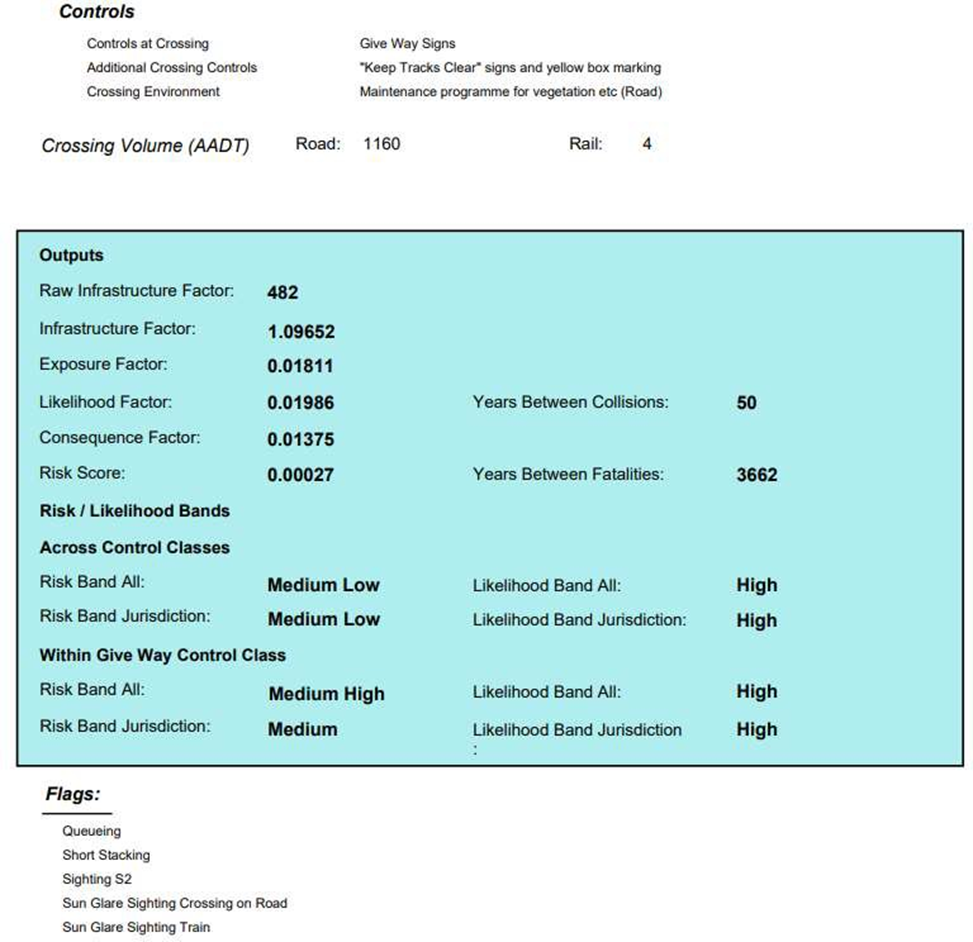
Related Recommendations
On 22 February 2024, the Commission recommended that KiwiRail ensure its Permit to Enter system enables safety-critical work at level crossings to occur in a timely manner and supports the maintenance of level crossings by road controlling authorities.
On 22 February 2024, the Commission recommended that KiwiRail risk assess any regular propelling movements, including assessment of the locomotive cab ergonomic environment, to ensure the risks to both road and rail users are managed.
